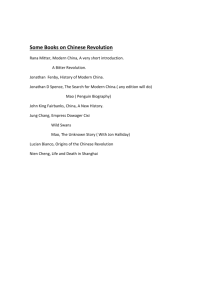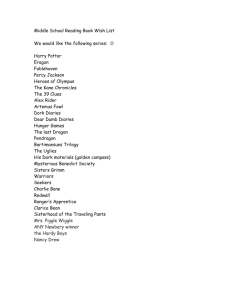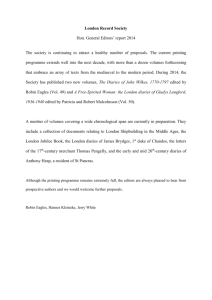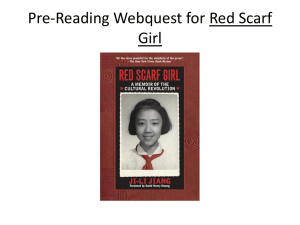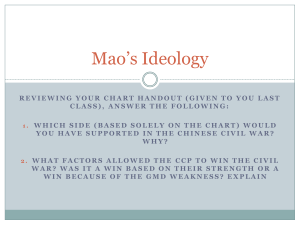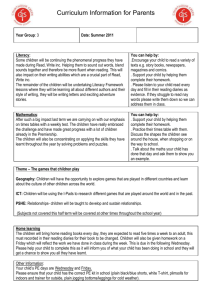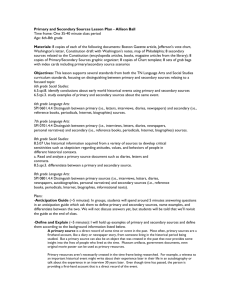Researching with the Proletarian Cultural Revolution in China at the
advertisement
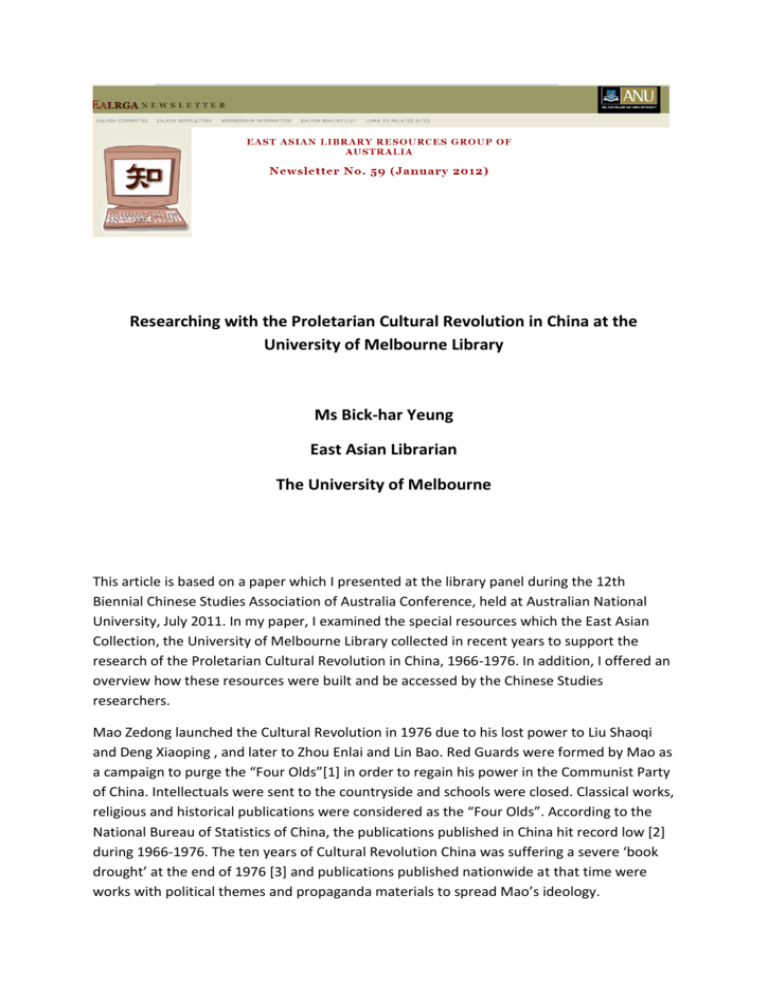
Researching with the Proletarian Cultural Revolution in China at the University of Melbourne Library Ms Bick-har Yeung East Asian Librarian The University of Melbourne This article is based on a paper which I presented at the library panel during the 12th Biennial Chinese Studies Association of Australia Conference, held at Australian National University, July 2011. In my paper, I examined the special resources which the East Asian Collection, the University of Melbourne Library collected in recent years to support the research of the Proletarian Cultural Revolution in China, 1966-1976. In addition, I offered an overview how these resources were built and be accessed by the Chinese Studies researchers. Mao Zedong launched the Cultural Revolution in 1976 due to his lost power to Liu Shaoqi and Deng Xiaoping , and later to Zhou Enlai and Lin Bao. Red Guards were formed by Mao as a campaign to purge the “Four Olds”[1] in order to regain his power in the Communist Party of China. Intellectuals were sent to the countryside and schools were closed. Classical works, religious and historical publications were considered as the “Four Olds”. According to the National Bureau of Statistics of China, the publications published in China hit record low [2] during 1966-1976. The ten years of Cultural Revolution China was suffering a severe ‘book drought’ at the end of 1976 [3] and publications published nationwide at that time were works with political themes and propaganda materials to spread Mao’s ideology. The University of Melbourne Library started to collect Cultural Revolution resources about 10 years ago. Materials collected comprise propaganda materials, textbooks, children books, posters, Red Guard newspapers and working diaries ….. They were gifts presented to the Library as well as purchased from private collections and the second-hand book market. The R.F. Price Collection [4] Dr. R. F. Price is a scholar of comparative education. He donated his private Chinese book collection, over 1200 volumes to our Library in 2007. The collection was purchased during his visits to China 1965-67, and his later subsequent visits to China and Hong Kong. It has a strong focus on politics, the propaganda of Marxism-Leninism and Mao’s thoughts, textbooks and children books. The textbook collection covers a wide range of subjects from art and humanities to sciences, from primary to high schools. There are basic reference works for vocational practices such as for “barefoot doctors”, workers and peasants. Among the textbooks, worthwhile to mention is that there are many “trial editions” (试用本). These trial editions were adopted due to that the older textbooks were considered one of the Four Olds and were banned. By examining the textbooks, interestingly I found that Mao’s quotations were quoted in black and boldface in the context, including science subject textbooks. Textbooks – The R. F. Price Collection There are more than 200 volumes of children books in the R. F. Price Collection. Children books ranging from nursery rhymes to stories and children literature published during the Cultural Revolution were appeared to urge children to follow Mao’s instruction and the communist ideology, such as class struggle and Maoist thought [5]. Examples are books on Anti-Confucianism and the Lin Biao Campaign, books about revolutionary heroes, little Red Guards, anti-US imperialism. There is a good representation of juvenile science literature. Children books – The R. F. Price Collection Working Diaries (Manuscripts) The 1st batch of working diaries containing 70 items written during the Cultural Revolution was added to our collection 10 years ago. These are unpublished working diaries mixing with some private diaries. Authors were anonymous. The contents of the diaries mainly were the reflections of Mao’s thought learning and the diaries of daily activities. The Diaries Collection grows to 140 titles during the past decade. New titles were selected and acquired from China’s second-hand book market. Authors of the diaries were students, red guards, teachers, staff from learning institutions and government officials. The contents consist of authors’ learning notes and reflections, working notes, diaries and documents. Some diaries even contained newspaper clippings and photos of the author and families. Working Diary (manuscript) Red Guard Newspapers and publications Our library has several hundred pieces of Red Guard Newspapers and publications. In 1967, registered newspapers in China reduced from 343 titles to 43 titles [6] due to political movements. Instead, Red Guard Groups all over the nation had published more than 5000 title of newspapers. These Red Guard Newspapers were the major propaganda materials published locally to support the political struggle movements. Chen [7] classified the contents of these newspapers into the following five categories: “大批判” Criticism on attacking party members. 首长讲话”和文件 Party leaders’ speeches and documents. “派性斗争”和武斗的消息 News on purges and fights between parties. “路线斗争”的历史资料 Historical information on the Correct Line Struggle. “文革”组织学习毛主席著作、首长讲话、中央文件的心得体会,分析讨论形势的意 见 Learning from Mao’s thought, leaders’ speeches and party’s documents. Among the Red Guard publications, many were pamphlets which had individual titles and each title had a special topic. Red Guard Newspapers Acquisitions Apart from the R.F. Price Collection, the acquisitions of above-mentioned materials were purchased from the second-hand market in China. I searched the Kongfz.com 孔夫子网 and the following subject areas have been my favorite categories for selection: Children books 少儿类 Red documents 红色文献 Story picture books 连环画 Cultural Revolution resources 文革书刊资料 I have dealers in China and in Melbourne assisting me to obtain the books which I had selected from the Kongfz.com. In many occasions, the contents of these materials were still politically sensitive that dealers in China were unwilling to acquire for us. As a result, I have to rely on our Melbourne book dealer to supply the politically sensitive materials. On the other hand, my selection is heavily relied on the information provided by the web, there are potential risks that what I select might not be what I get. Access The Cultural Revolution materials we collected are in different sizes and in different formats. It has been very time consuming to catalogue each title in full record. We managed to catalogue every printed book, included children books. Each title can be searched by author, title, subject headings and keywords. For posters, diaries and Red Guard newspapers, we gave each type of material a collective title and added the individual title of each piece of work in the content field of the bibliographic record. This arrangement allows each individual piece of work to be searched and retrieved by title and keywords, sometimes by subjects. The bibliographic record of the R. F. Price Collection. I am putting together the information of our Cultural Revolution resources in a LibGuide entitled “The Great Proletarian Cultural Revolution of China”. When it is completed, it will serve as a one-stop guide for researchers how to access to this valuable collection. The LibGuide – under construction Our Cultural Revolution of China materials are not for loan. Items can be searched and requested from the University of Melbourne library catalogue (http://cat.lib.unimelb.edu.au) and they have to be used at the Reading Room of the Special Collections, 3rd floor, Baillieu Library. For further enquiries, please email Bick-har Yeung (bhy at unimelb.edu.au) Remark: Photos in this article are photographed by the author. Endnotes: [1] The Four Olds: "Old ideas, old culture, old customs, old habits." [2] National Bureau of Statistics of China, ed. Books, Magazines and Newspaper Published, In 50 Years of New China 1949-1999: China Statistics Press, 1999. [3] Barme', Geremie. "Notes on Publishing in China, 1976-1979." The Australian Journal of Chinese Affairs, no. 4: 167-74. [4] Yeung, Bickhar. "The R. F. Price Collection." University of Melbourne Collections, no. 5 (2009): 41-43. [5] 杜晓沫. "百花不见, 杂草横陈 : 简论处"文革"十年的中国儿童文学." 作家杂志, no. 2 (2009): 23-24. [6] 贺吉元. "文革初期的红卫兵报纸." 文史博览, no. 4 (2005): 38-41. [7] 陈东林. “文革群众组织报刊研究 " 历史研究 (2006), http://go.paowang.net/news/3/2006-10-15/20061015210431.html
